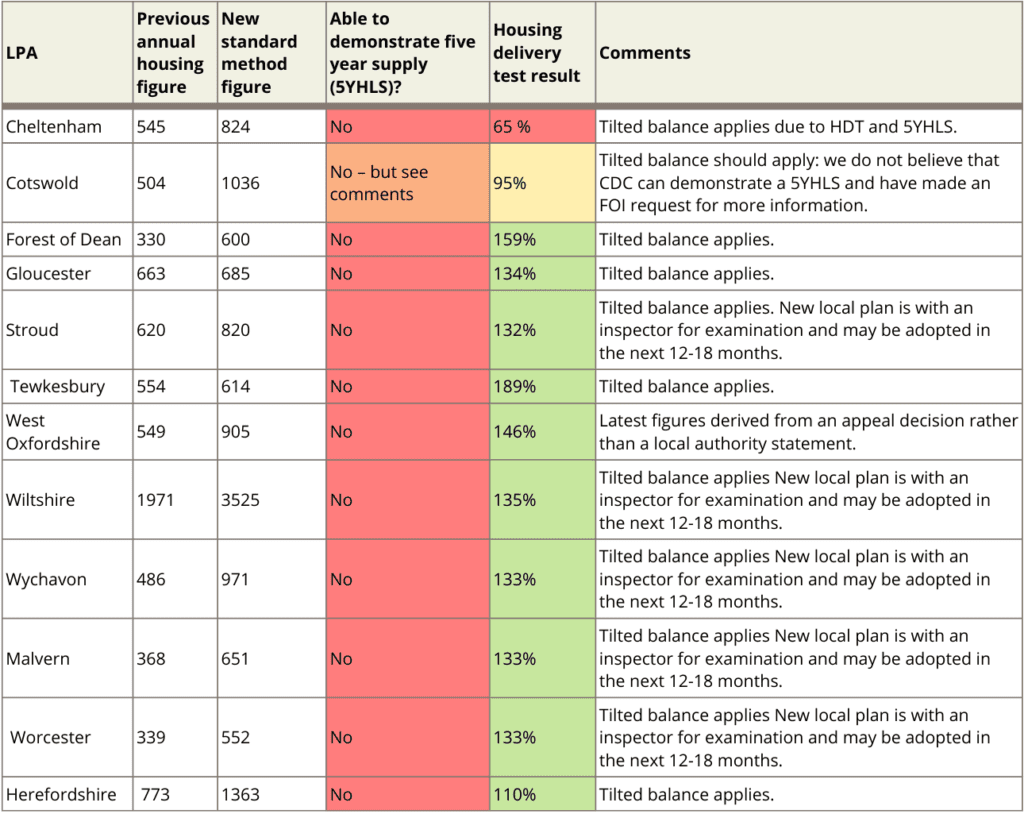A developer and landowner’s guide to changes within the revised National Planning Policy Framework – December 2024
The revised National Planning Policy Framework (NPPF) was published on 12 December. From that date, local planning authorities (LPAs) must refer to it in decision making. Here, we summarise some of the key takeaways, and our predictions for the next 12-18 months. This is not intended to be a list of all the changes. We have included those which we consider will most significantly impact on our clients and contacts.
1. Local authorities will need to provide a lot more housing
- Alongside the NPPF came changes to the ‘standard method’ for calculating housing need. The NPPF also reinstates a requirement for all authorities to provide a five-year supply of housing. The standard method changes result in an increase to housing targets for all Gloucestershire authorities and many other LPAs where we regularly work. In many cases, this has left authorities unable to demonstrate a five-year housing land supply.
- Where a local authority does not have a five-year housing land supply (with a suitable buffer, usually 5%), the relevant policies in their local plan become out of date. When local plan policies are out of date, a principle known as the tilted balance applies. This means that planning permission should be granted unless specific and limited exceptions apply.
- This creates opportunities for development, which is sustainably located, but is otherwise contrary to policy (for example it is within a village, but the wrong side of a settlement boundary).
REVISED HOUSING FIGURES FOR KEY LPAs
The table below sets out figures for several local authorities, including their housing delivery test results. As with the previous version of the NPPF, authorities who have failed to deliver at least 85% of the required number of dwellings across the previous 3 years need to include a 20% buffer in their calculation. The titled balance applies where delivery is less than 75%.

2. SMEs have some support, but need much more
The government has made some small changes which support SME housebuilders by recognising the importance of small and medium sites.
Also, in general we believe that there will be opportunities for proportionate growth in small, edge of settlement locations (which are often the sites put forward by SMEs). These opportunities arise as a result of the increased housing requirements outlined above, and the move back to a five-year housing land supply for all authorities.
However, we believe much more could have been done. The Government has suggested that supporting the growth of small to medium sized housebuilders is a crucial part of their strategy. They intend to give this further consideration in 2025, in their national development management policies. SF Planning acts on behalf of many SME developers and will continue to monitor the developments, providing summaries and guidance through our own articles and resources.
3. A more flexible approach to green belt development, and use of land more generally
Changes to green belt and brownfield land policy could have an indirect positive impact on SMEs, too.
Hardstanding areas now clearly fall within the definition of previously developed land (although with agricultural buildings excluded as previously). This may create further opportunities, particularly in the green belt.
Proposals for development on brownfield land should now be approved unless substantial harm would be caused.
As before, green belt boundaries should only be reviewed in exceptional circumstances. Importantly, instances where an authority cannot meet its identified need for homes now qualifies as an exceptional circumstance.
The NPPF introduces a sequential approach to development in the green belt.

Grey belt is a new designation defined as either;
i) Previously developed land; OR
ii) Any other green belt land which does not contribute to
- Checking unrestricted sprawl
- Preventing neighbouring towns from merging
- Preserving setting and special character of towns
The above applies with some specific exceptions where land is within an area or asset of importance.
There will inevitably be debate about whether land meets the tests or not, including whether policies relating to areas such as national landscapes (previously AONBs) would constitute a strong reason for refusal. If you have land that could be suitable for development, we recommend seeking advice early. SF Planning can offer site appraisals and policy information, as well as suggesting a strategy for any applications.
Further changes appear to advocate for edge of green belt release (although not explicitly). There are also subtle differences in the wording. These should make it easier for applications to meet some of the exceptions to inappropriate development in the green belt.
Sites for 10 or more homes in the green belt will be subject to a set of ‘golden rules’. These normally require the provision of 50% affordable housing, or an alternative level set in the new local plan (with up to 50% applying until then). Improvements to infrastructure and provision/improvement of publicly accessible green spaces are also required.
Vitally, in line with recent case law, compliance with the golden rules should now be given significant weight, in favour of the grant of planning permission.
Another welcome change is the confirmation that development should not be regarded as inappropriate if LPAs cannot demonstrate a five-year housing land supply.
4. On the horizon…The changes should provide some clarity, and encourage more residential development in the medium to long term.
From July 2026, a 20% buffer will apply to local authority housing land supply figures in the following circumstance:
- where LPAs reply on housing land supply figures in local plans examined under previous version of the NPPF
- and where their annual average housing requirement is 80% or less of the revised standard method figure.
Some local authorities, whose local plans have recently been adopted, or will be shortly adopted, will be able to lock in lower housing figures (ordinarily for up to five years from the date of adoption). However, they will still need to maximise deliverable supply to avoid being unable to demonstrate a five-year supply in July 2026 and beyond.
Locally, we predict that Worcester, Malvern, Wychavon, Stroud, and Wiltshire may be unable to demonstrate a five-year housing land supply when the 20% buffer is added, even if their local plans (all currently at examination) are adopted as drafted. Although these authorities are likely to experience difficulties until their plan is adopted too, especially since the four-year requirement has been removed.
It is also worth keeping an eye on those authorities where housing delivery is only just above the threshold. If they manage to increase their supply but don’t see enough completions then this may mean tilted balance still applies.
Get in Touch
This information is intended as a summary of some of the key changes to national planning policy.
If you have any questions or would like to discuss land which you feel may be suitable for development now or in the future, please contact us.
We particularly recommend getting in touch if you have land in the green belt or land on the edge of settlements, which has previously been discounted.
e: info@sfplanning.co.uk
t: Cheltenham: 01242 231575 | Gloucester: 01452 527997 | London: 020 3763 8005
SF Planning – What we do

